Using Mobile Devices in Environmental Education and Education for Sustainable Development—Comparing Theory and Practice in a Nation Wide Survey
Abstract
:1. Introduction

| Potential Benefits | Obstacles |
|---|---|
|
|
|
|
|
|
|
|
|
|
|
- (1)
- Goal orientation: Is an educational purpose for the MED-supported activity clearly formulated and adequately outlined?
- (2)
- Educational concept: Is the MED-supported activity adequately structured? Are the participants’ interests and requirements considered?
- (3)
- Pedagogical orientation: Are the pedagogical capabilities of MED-supported activities adequately used? Are multiple learning-opportunities provided?
- (4)
- Achievement: How strong is the potential for achievement within the MED-supported activity? How is it measured and are (empirical) data accessible?
- (5)
- Motivation and interest: How strong is the potential of the MED-supported activity to motivate learners? Is the motivation just grounded on a novelty effect?
- (6)
- Users participation: To what extent are the users able to participate and to create their own content within the MED-supported activity?
- (7)
- Methodological use of MEDs: How are MEDs used—just for navigation or for more constructive activities (e.g., documentation, data acquisition, creating and sharing information).
2. Methodology
- (a)
- Educational and pedagogical dimension: To what extent are constructivist learning paradigms observable within the activities and are they supported by mobile devices? Methods foster different learning paradigms in different manners (e.g., step-by-step learning or self-determined discoveries, informal setting or formal learning, exposition or exploration, collaborative or individual activities).
- (b)
- Content-related dimension: Which content-related aspects are fostered? What are the aims of the activity? Are they fruitfully supported by the use of mobile devices and are learners’ interests addressed adequately?
- (c)
- Technological dimension: What are the benefits and limitations which mobile technology provides for the educational activities in environmental education and ESD?
- (d)
- Economic dimension: Which are the economic prerequisites to develop a project-based educational activity using mobile devices that is viable in the long-term?
- (i)
- Target groups: Who is addressed with MED-supported educational activities?
- (ii)
- Provider: Which institutions provide educational activities using mobile devices?
- (iii)
- Technology: Which devices are used? Which network technology, platforms and digital tools are used?
- (iv)
- Educational and pedagogical orientation: Which are the educational concepts underlying the educational activities supported with mobile devices?
- (v)
- Environmental education/ESD inputs and outcomes: Which goals of environmental education/ESD are intended within the educational activities using mobile devices and which outcomes are expected?
2.1. Questionnaire Development and Online Survey
| Sub-Dimensions | Item Examples |
|---|---|
| social interaction (5 items, Cronbach’s α = 0.90) | - participants do … vs. … do not discuss with others - participants are … vs. … are not responsible for the common result of the activity |
| degree of media orientation (2 items, Cronbach’s a = 0.73) | - educational activity is strongly … vs. … not influenced by digital media |
| (socio-inter)active learning (3 items, Cronbach’s a = 0.64) | - participants are passive … vs. …active during the activity - participants are receptive … vs. …productive |
| educational setting (5 items, Cronbach’s a = 0.71) | - participants follow a predefined time-schedule … vs. … have a self-determined working speed within the educational program - MED-activity provides (formal) … vs. … does not provide connection to curricula (informal) |
| goal orientation (4 items, Cronbach’s a = 0.68) | - learning goals are set … vs. … participants set their own goals - topics of the educational activity are predefined … vs. … participants work on self-determined topics |
| Dimension | Item Examples |
|---|---|
| EE-dimensions (inputs) (10 items, Cronbach’s α = 0.70) | Which nature experience do you foster with your activity? - aesthetic dimension (perceiving the beauty of nature) - social dimension (human-animal relationship) - recreational dimension (leisure-time in nature) |
| ESD-criteria (inputs) (6 items, Cronbach’s α = 0.82) | Which criteria does your activity meet? - global and local aspects were involved - social, cultural, economic and ecological aspects were discussed |
| EE-targets (outputs) (3 items, Cronbach’s α = 0.68) | Which are the goals of your activity? - environmental knowledge - attitudes towards nature - pro-environmental behavior |
| ESD-competences (outputs) (12 items, Cronbach’s α = 0.82) | - being able to take one’s else perspective - being able to participate |
2.2. Nationwide Survey with Online Questionnaire
3. Results
3.1. Descriptive Analyses of the Online Survey Data
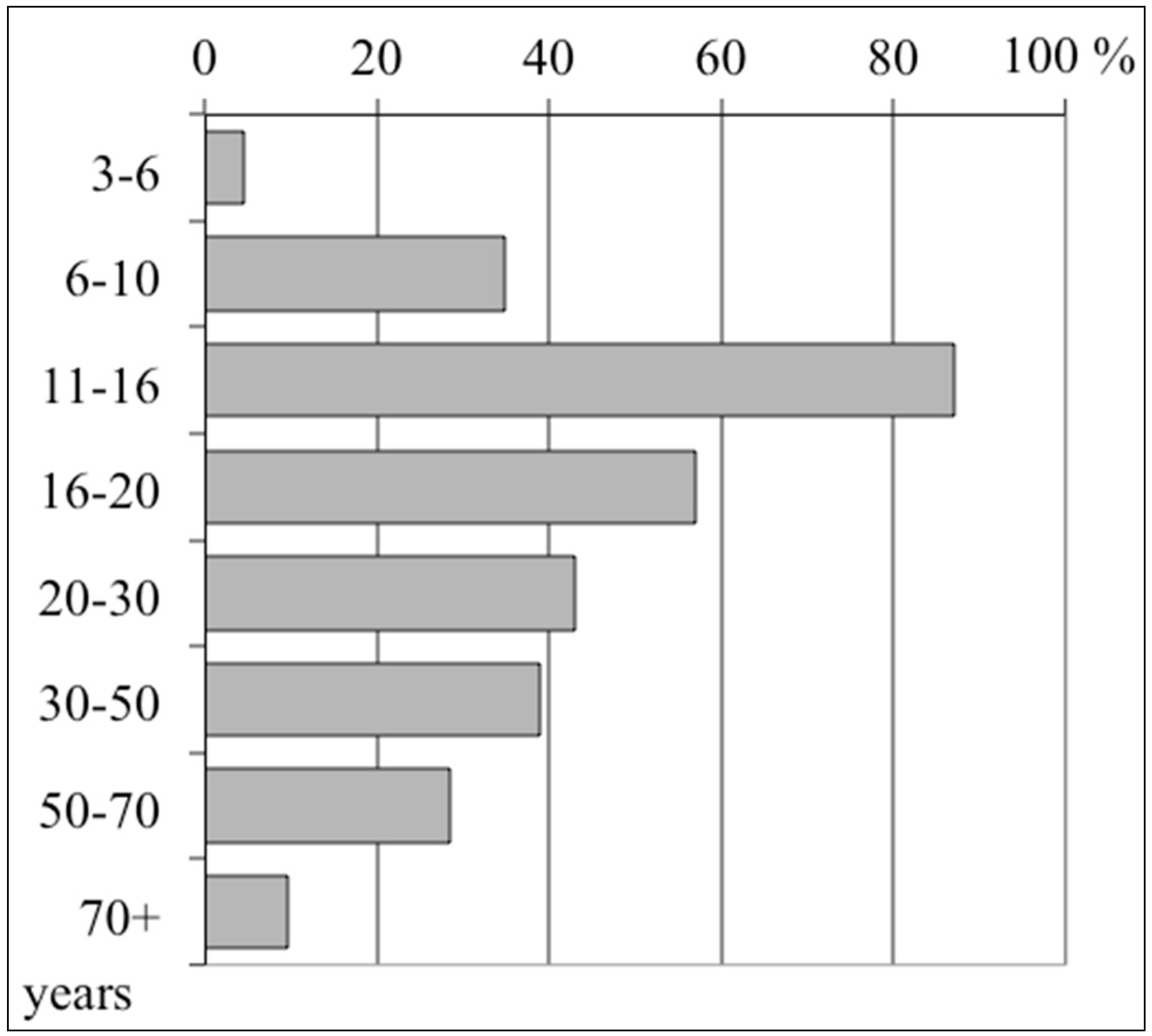
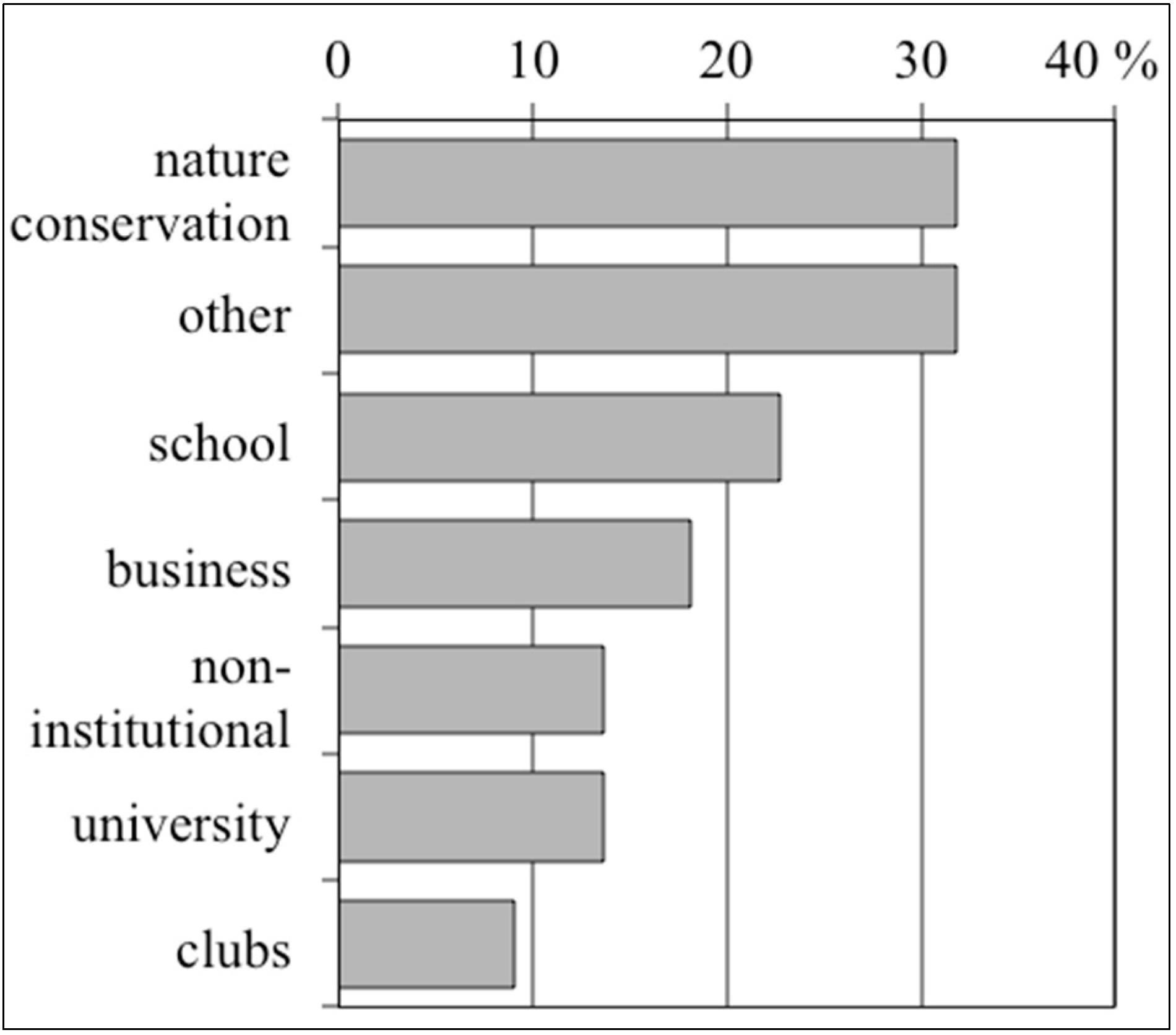
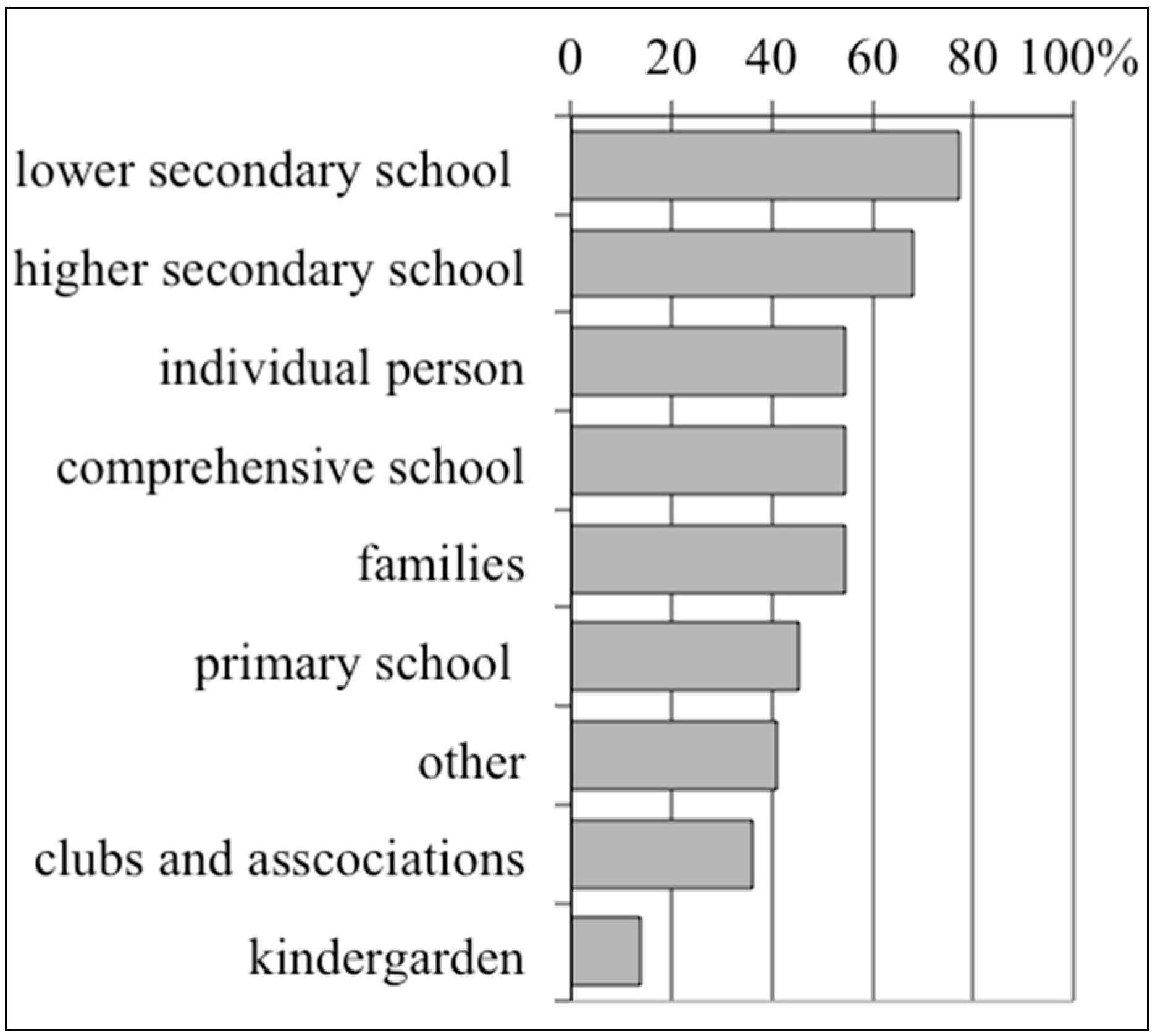
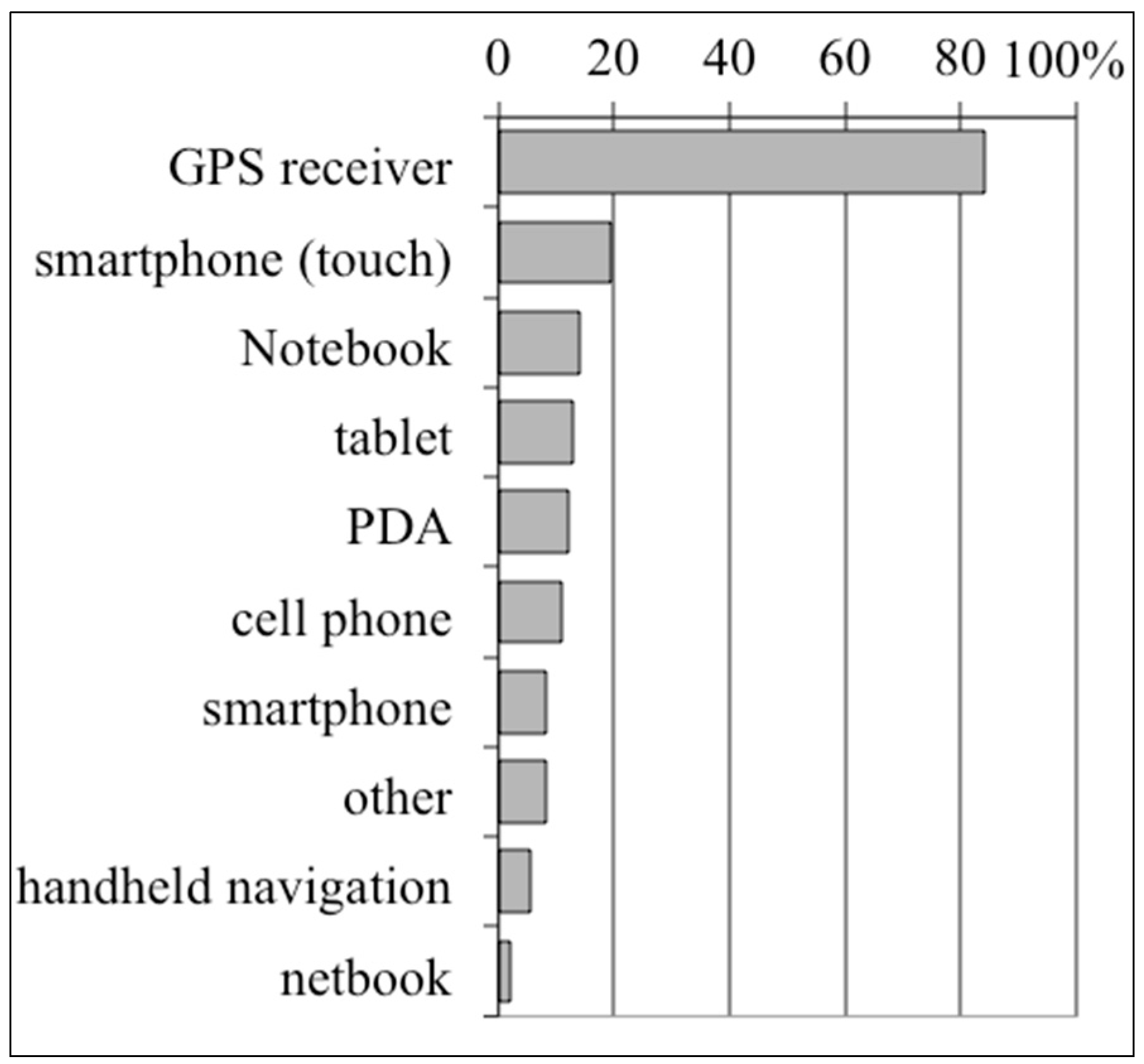
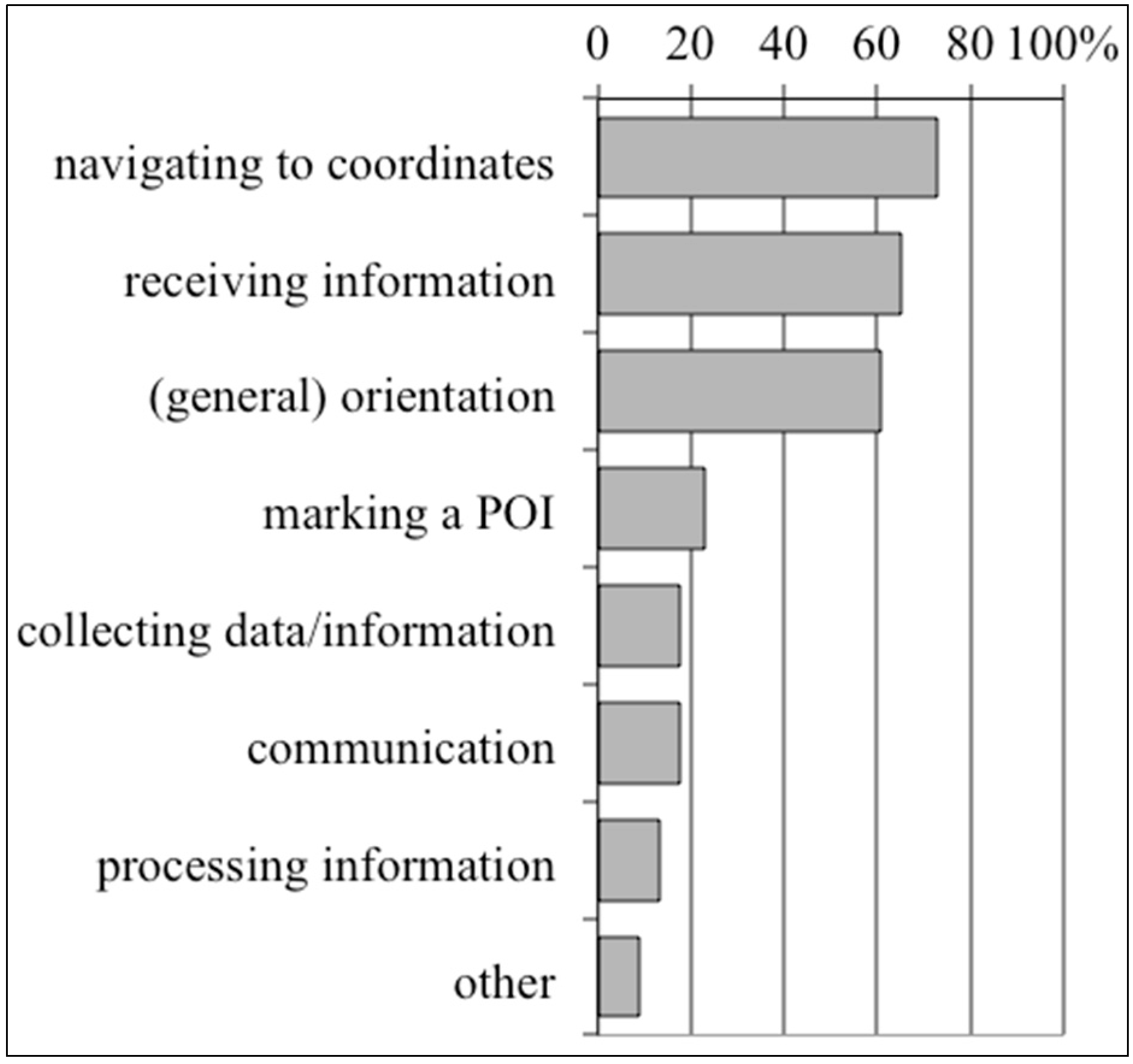
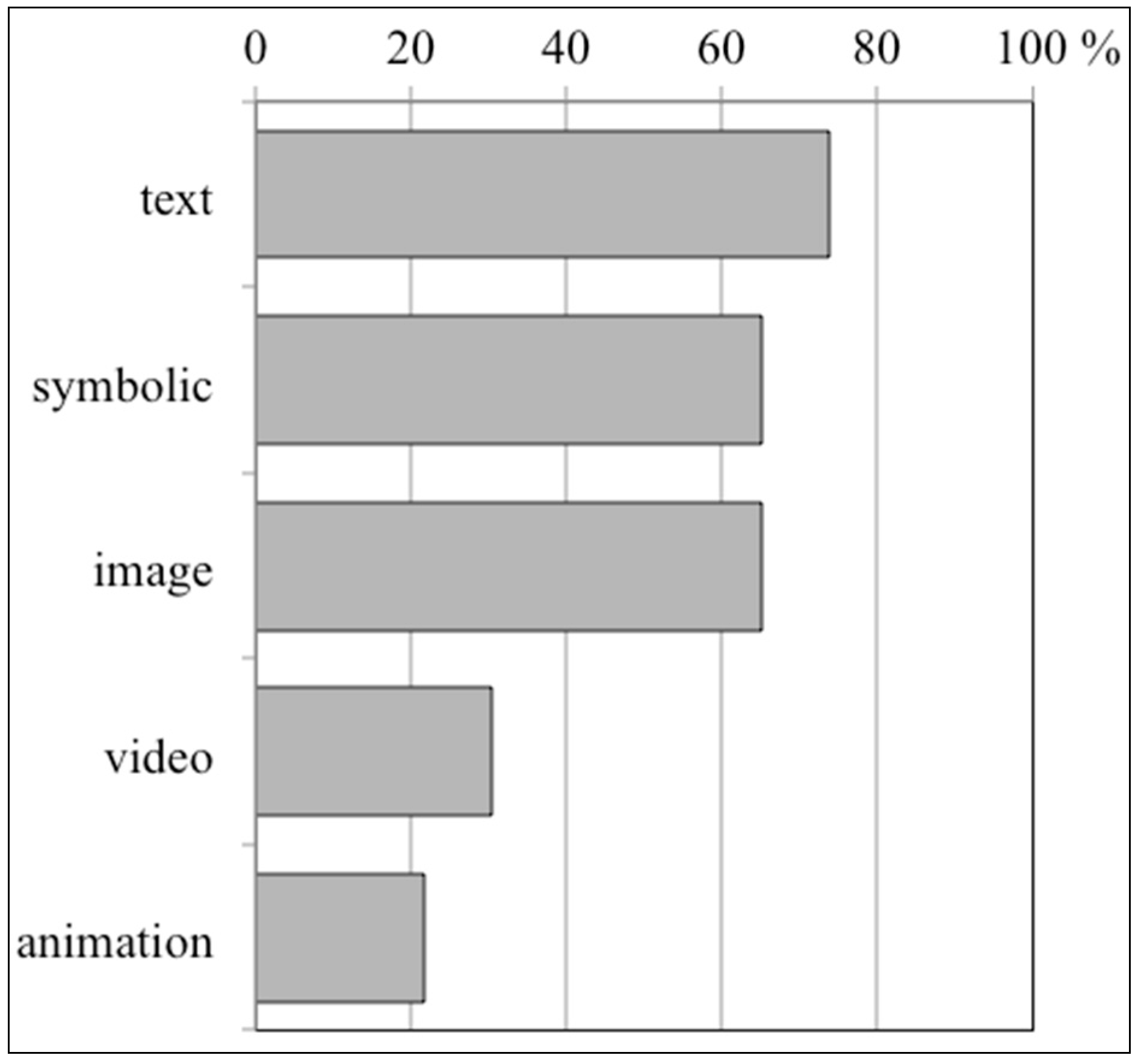

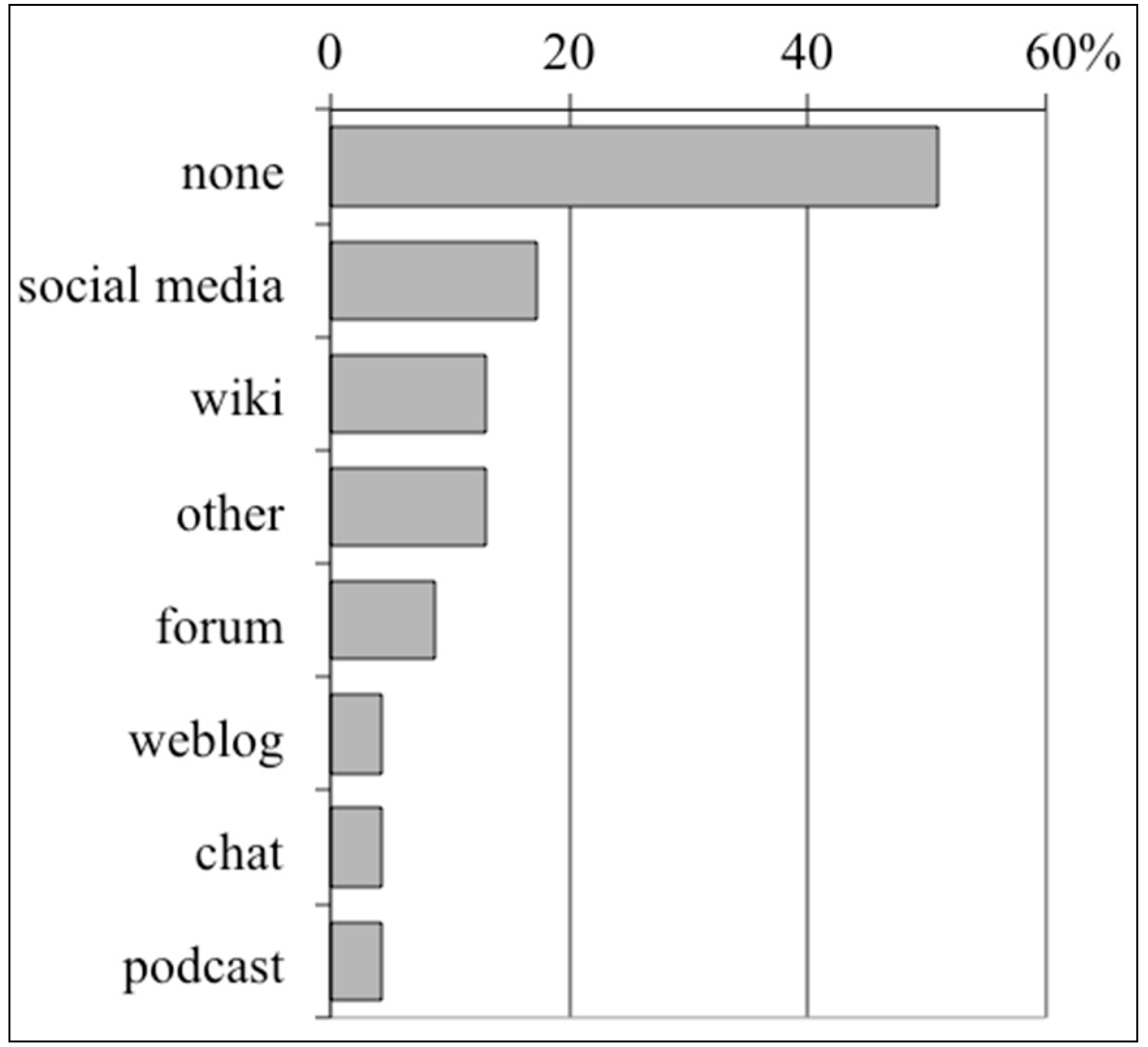
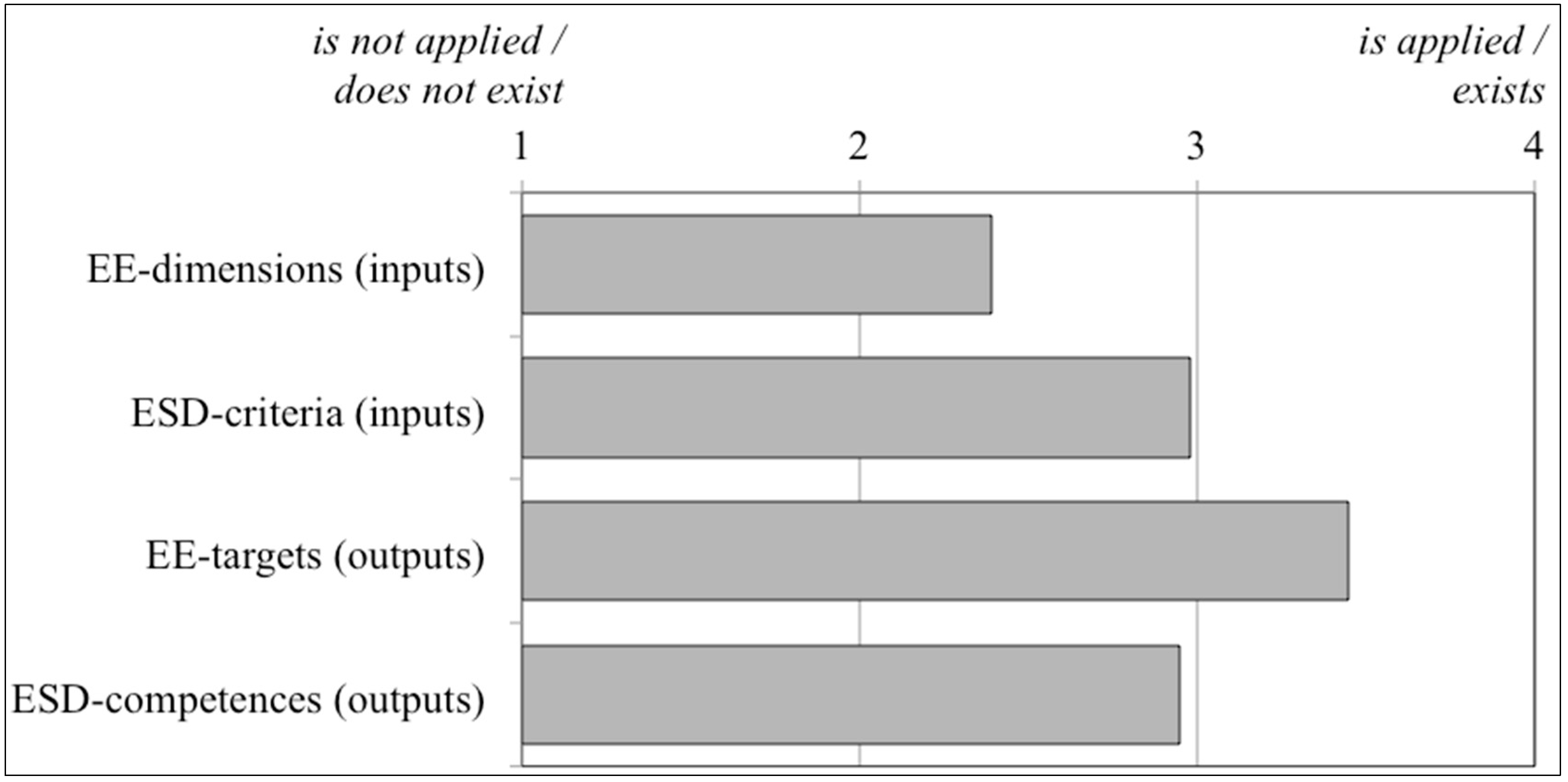
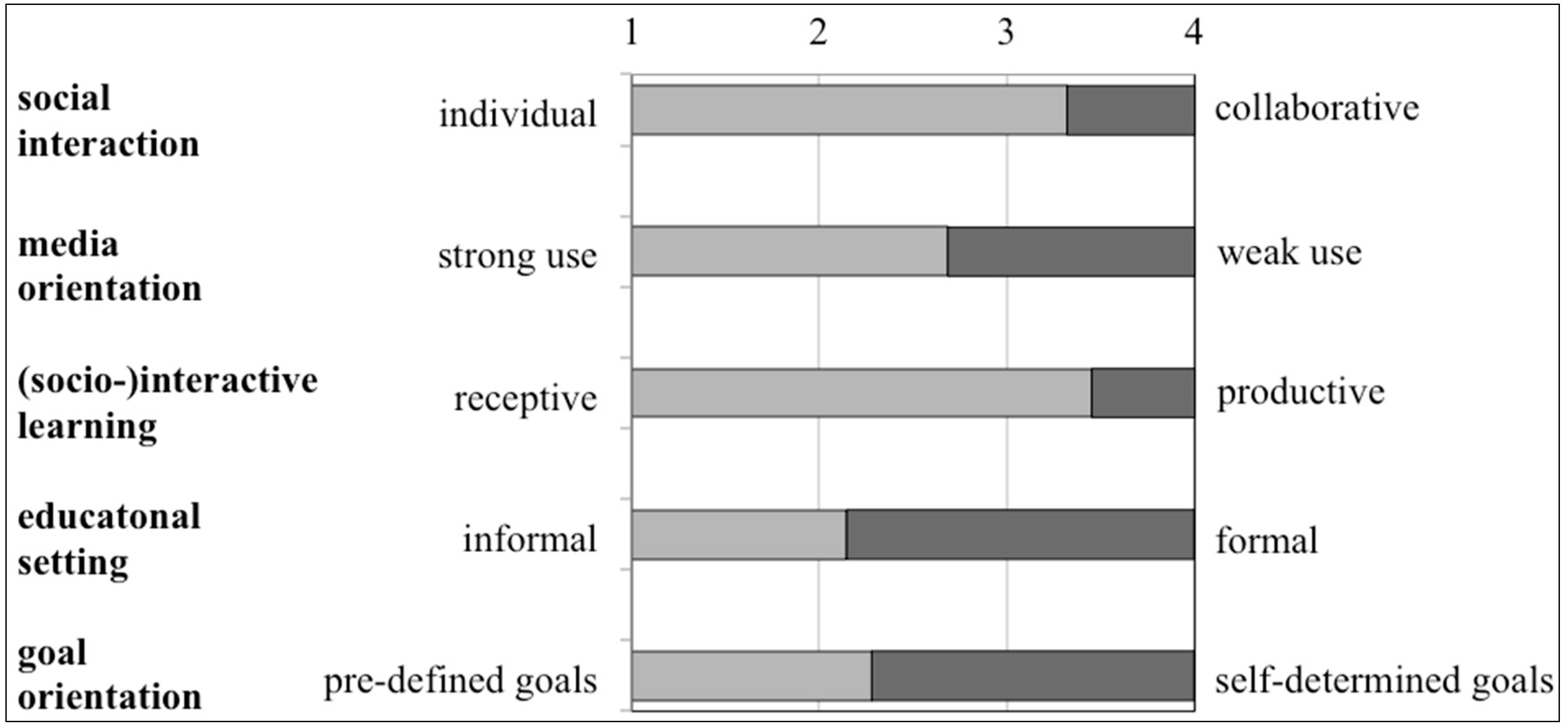
3.2. Classification of the Educational Activities
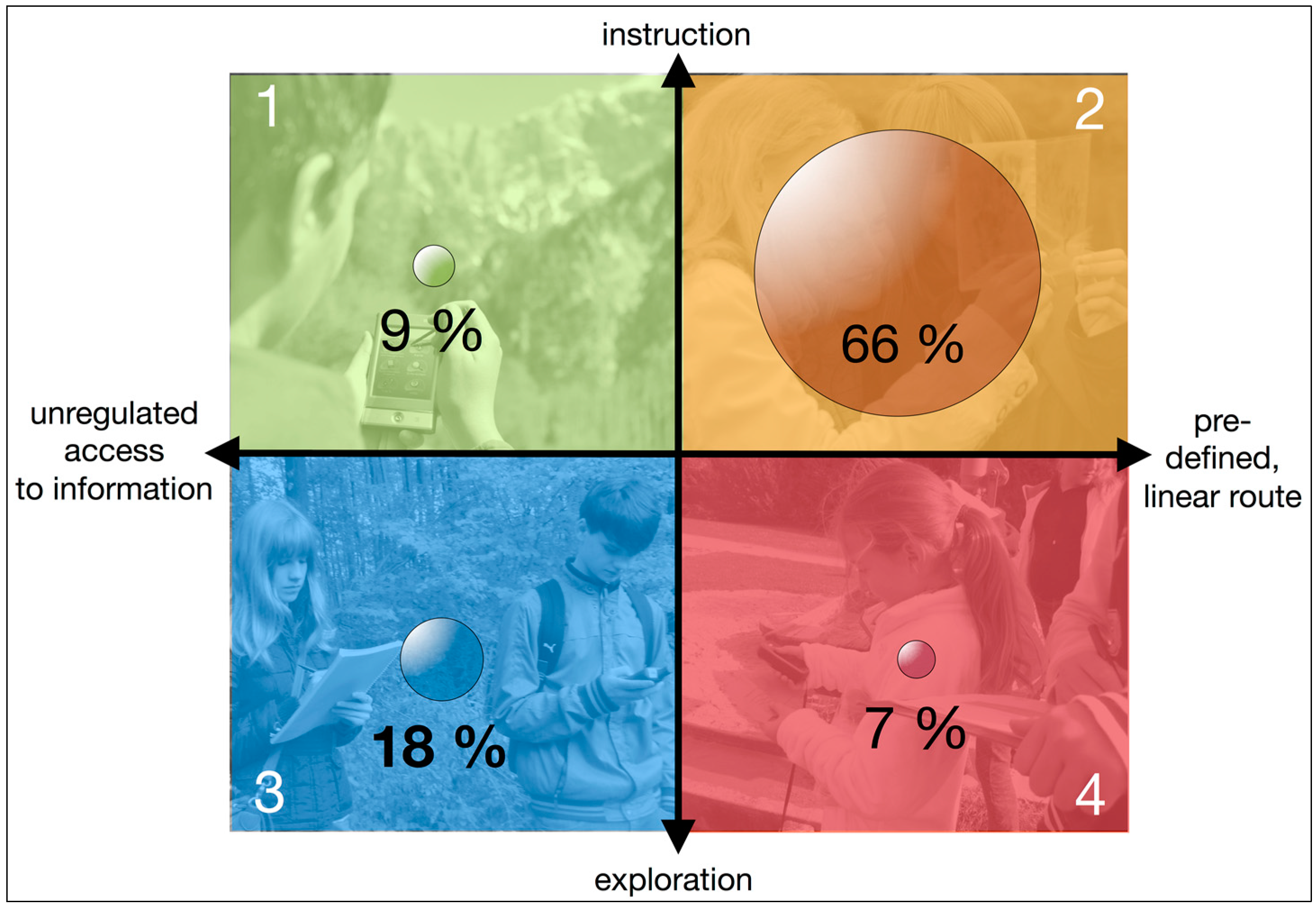
3.3. Divergences between Delphi Results and Survey Data
4. Discussion and Conclusions
Acknowledgments
Author Contributions
Conflicts of Interest
References and Notes
- Brämer, R. Natur Obskur. Wie Jugendliche Heute Natur Erfahren; Oekom Verlag Germany: München, Germany, 2006. [Google Scholar]
- Manni, A.; Ottander, C.; Sporre, K.; Parchmann, I. Perceived learning experiences regarding Education for sustainable development—within Swedish outdoor education traditions. Nordic Stud. Sci. Educ. 2013, 2, 187–205. [Google Scholar]
- Gruenewald, D.A. The best of both worlds: A critical pedagogy of place. Environ. Educ. Res. 2003, 14, 308–324. [Google Scholar] [CrossRef]
- Rickinson, M.; Dillon, J.; Teamey, K.; Morris, M.; Choi, M.Y.; Sanders, D.; Benefield, P. A Review of Research on Outdoor Learning; Field Studies Council: Shrewsbury, UK, 2004. [Google Scholar]
- Zecha, S. Geocaching, a tool to support environmental education!?—An explorative study. Educ. Res. 2012, 1, 177–188. [Google Scholar] [CrossRef]
- Sharples, M.; Sánchez, I.; Milrad, M.; Vavoula, G. Mobile Learning: Small devices, Big Issues. In Technology Enhanced Learning: Principles and Products; Balacheff, N., Ludvigsen, S., Jong, T.D., Lazonder, A., Barnes, S., Eds.; Springer: Heidelberg, Germany, 2009; pp. 233–249. [Google Scholar]
- Brown, E. Introduction to location-based. In Education in the Wild: Contextual and Location-Based Mobile Learning in Action; Brown, G.E., Ed.; A Report from the STELLAR Alpine Rendez-Vous Workshop Series; Learning Sciences Research Institute, University of Nottingham: Nottingham, UK, 2010; pp. 7–9. [Google Scholar]
- Sharples, M. Foreword. In Education in the Wild: Contextual and Location-Based Mobile Learning in Action; Brown, G.E., Ed.; A Report from the STELLAR Alpine Rendez-Vous Workshop Series; Learning Sciences Research Institute, University of Nottingham: Nottingham, UK, 2010; pp. 4–6. [Google Scholar]
- Ruchter, M.; Klar, B.; Geiger, W. Comparing the effects of mobile computers and traditional approaches in environmental education. Comput. Educ. 2010, 54, 1054–1067. [Google Scholar] [CrossRef]
- Kremer, D.; Schlieder, C.; Feulner, B.; Ohl, U. Spatial Choices in an Educational Game. In Proceedings of the International Conference on Games and Virtual Worlds for Serious Applications (VS-GAMES-13), Poole, UK, 11–13 September 2013; Gatzidis, C., Zhang, J., Eds.; pp. 134–137.
- Lai, C.-H.; Yang, J.-C.; Chen, F.-C.; Ho, C.-W.; Chan, T.-W. Affordances of mobile technologies for experiential learning: The interplay of technology and pedagogical practices. Comput. Assist. Learn. 2007, 23, 326–337. [Google Scholar] [CrossRef]
- Uzunboylu, H.; Cavus, N.; Ercag, E. Using mobile learning to increase environmental awareness. Comput. Educ. 2009, 42, 381–389. [Google Scholar] [CrossRef]
- Avouris, N.; Yiannoutsou, N. A review of mobile location-based games for learning across physical and virtual spaces. J. Univers. Comput. Sci. 2012, 18, 2120–2142. [Google Scholar]
- Wetzel, R.; Blum, L.; Oppermann, R. Tidy city: A location-based game supported by in-situ and web-based authoring tools to enable user-created content. In Proceedings of the International Conference on the Foundations of Digital Games, Raleigh, NC, USA, 29 May–1 June 2012; ACM: New York, USA, 2012; pp. 238–241. [Google Scholar]
- Rubino, I.; Barberis, C.; Xhembulla, J.; Malnati, G. Integrating a Location-Based Mobile Game in the Museum Visit: Evaluating Visitors’ Behaviour and Learning. ACM J. Comput. Cult. Herit. 2015, 8, 1–18. [Google Scholar] [CrossRef]
- Schaal, S.; Schaal, S.; Haas, A.; Lude, A. BioDiv2Go—Using Geogames and location-based simulations to foster local biodiversity. In Proceedings of the European Science Education Research Association Conference, Helsinki, Finland, 31 August–4 September 2015.
- Wake, J. Mobile, Location-Based Games for Learning Developing, Deploying and Evaluating Mobile Game Technology in Education. Ph.D. Thesis, University of Bergen, Bergen, Norway, 2013. [Google Scholar]
- Bianchi-Berthouze, N. Understanding the Role of Body Movement in Player Engagement. Hum. Comput. Interact. 2013, 28, 40–75. [Google Scholar]
- Huizenga, J.; Admiraal, W.; Akkerman, S.; Dam, G.T. Mobile game-based learning in secondary education: Engagement, motivation and learning in a mobile city game. J. Comput. Assist. Learn. 2009, 25, 332–344. [Google Scholar] [CrossRef]
- Doswell, J.; Harmeyer, K. Extending the Serious Game Boundary: Virtual Instructors in Mobile Mixed Reality Learning Games. In Proceedings of the Digital Game Research Association Conference (DIGRA), Tokyo, Japan, 24–28 September 2007; Volume 4, pp. 524–529.
- Facer, K.; Joiner, R.; Stanton, D.; Reid, J.; Hull, R.; Kirk, D. Savannah: Mobile gaming and learning? J. Comput. Assist. Learn. 2004, 20, 399–409. [Google Scholar] [CrossRef]
- Traxler, J. Will student devices deliver innovation, inclusion and transformation? J. Res. Cent. Educ. Technol. 2010, 6, 3–15. [Google Scholar]
- Forkel-Schubert, J. GPS in der Umweltbildung: Geocaching frisst Naturerleben. Ökopädnews 2010, 211, 36–37. [Google Scholar]
- Welsh, K.; France, D. Spotlight on … Smartphones and fieldwork. Geography 2012, 1, 47–51. [Google Scholar]
- Constantinidis, D.; Smith, W.; Chang, S.; Lewi, H.; Saniga, A.; Sadar, J. Designing Fieldwork with Mobile Devices for Students of the Urban Environment. In Electric Dreams, Proceedings of the Ascilite, Sydney, Australia, 1–4 December 2013; Carter, H., Gosper, M., Hedberg, J., Eds.; pp. 178–188.
- Schaal, S.; Gruebmeyer, S.; Matt, M. Outdoors and Online—Inquiry with mobile devices in pre-service science teacher education. World J. Educ. Technol. 2012, 4, 113–125. [Google Scholar]
- Vavoula, G.; Pachler, N.; Kukulska-Hulme, A. Researching Mobile Learning: Frameworks, Tools and Research Designs; Peter Lang: Bern, Switzerland, 2010. [Google Scholar]
- Lude, A.; Schaal, S.; Bullinger, M.; Bleck, S. Mobiles, Ortsbezogenes Lernen in der Umweltbildung und Bildung für Nachhaltige Entwicklung; Schneider: Hohengehren, Germany, 2013. [Google Scholar]
- Bleck, S.; Bullinger, M.; Lude, A.; Schaal, S. Electronic mobile devices in environmental education (EE) and education for sustainable development (ESD) Evaluation of concepts and potentials. Procedia—Soc. Behav. Sci. 2012, 46, 1232–1236. [Google Scholar] [CrossRef]
- Wright, S.; Parchoma, G. Technologies for learning? An actor-network theory critique of ‘affordances’ in research on mobile learning. Res. Learn. Technol. 2011, 3, 247–258. [Google Scholar] [CrossRef]
- Olk, T. Informelles Lernen. Zum Konzept des informellen Lernens. J. Lehrerinnen Lehrerbildung 2009, 1, 50–54. [Google Scholar]
- Rauschenbach, T. Informelles Lernen. Möglichkeiten und Grenzen der Indikatorisierung. In Steuerung durch Indikatoren. Methodologische und Theoretische Reflektionen zur Deutschen und Internationalen Bildungsberichterstattung; Tippelt, R., Ed.; Burdich: Opladen, Germany, 2009; pp. 35–53. [Google Scholar]
- Duit, R.; Treagust, D. Learning in Science-From Behaviourism Towards Social Constructivism and Beyond. In International Handbook on Science Education; Fraser, B., Tobin, K., Eds.; Kluwer: Dodrecht, The Netherlands, 1998; pp. 3–25. [Google Scholar]
- Schecker, H. Überprüfung der Konsistenz von Itemgruppen mit Cronbachs Alpha. In Methoden der Naturwissenschaftsdidaktischen Forschung; Krüger, D., Parchmann, I., Schecker, H., Eds.; Springer Spektrum: Berlin, Germany, 2014. [Google Scholar]
- Schmitt, N. Uses and abuses of coefficient alpha. Psychol. Assess. 1996, 8, 350–353. [Google Scholar] [CrossRef]
- Blömeke, S.; Kaiser, G.; Lehmann, R. Professionelle Kompetenz angehender Lehrerinnen und Lehrer—Wissen, Überzeugungen und Lerngelegenheiten deutscher Mathematikstudierender und–referendare—Erste Ergebnisse zur Wirksamkeit der Lehrerausbildung; Waxmann: Münster, Germany, 2008. [Google Scholar]
- Bögeholz, S. Nature experience and its importance for environmental knowledge, values and action—Recent German empirical contributions. Environ. Educ. Res. 2006, 12, 65–84. [Google Scholar] [CrossRef]
- Lude, A. Does nature experience or opinions of environmental ethics influence the pro-environmental behaviour of students? In Proceedings of the European Researchers in Didactics of Biology, Santiago de Compostela, Spain, 27 September–1 October 2000; pp. 391–403.
- Lude, A. Natur erfahren und für die Umwelt handeln—Zur Wirkung von Umweltbildung. NNA-Berichte 2006, 19, 18–33. [Google Scholar]
- Medienpädagogischer Forschungsverband Südwest. JIM-Studie 2012—Jugend, Information, (Multi-)Media; MPFS: Stuttgart, Germany, 2012. [Google Scholar]
- Medienpädagogischer Forschungsverband Südwest. JIM-Studie 2014—Jugend, Information, (Multi-)Media; MPFS: Stuttgart, Germany, 2014. [Google Scholar]
- Marfisi-Schottman, I.; George, S. Supporting Teachers to Design and Use Mobile Collaborative Learning Games. In Proceedings of the International Conference on Mobile Learning, Madrid, Spain, 28 February–2 March 2014; pp. 3–10.
- Heimonen, T.; Turunen, M.; Kangas, S.; Pallos, S.; Pekkala, P.; Saarinen, S.; Tiitinen, K.; Keskinen, T.; Luhtala, M.; Koskinen, O.; et al. Seek'N'Share: A platform for location-based collaborative mobile learning. In Proceedings of the 12th International Conference on Mobile and Ubiquitous Multimedia, Lulea, Sweden, 2–5 December 2013; pp. 38.1–38.4.
- Clough, G. Geolearners: Location-based informal learning with mobile and social technologies. IEEE Trans. Learn. Technol. 2010, 3, 33–44. [Google Scholar] [CrossRef]
- Koehler, M.; Mishra, P. Introducing TPCK. In Handbook of Technological Pedagogical Content Knowledge (TPCK) for Educators; AACTE Committee on Innovation and Technology, Ed.; Routledge: New York, USA, 2008; pp. 1–29. [Google Scholar]
© 2015 by the authors; licensee MDPI, Basel, Switzerland. This article is an open access article distributed under the terms and conditions of the Creative Commons Attribution license (http://creativecommons.org/licenses/by/4.0/).
Share and Cite
Schaal, S.; Lude, A. Using Mobile Devices in Environmental Education and Education for Sustainable Development—Comparing Theory and Practice in a Nation Wide Survey. Sustainability 2015, 7, 10153-10170. https://doi.org/10.3390/su70810153
Schaal S, Lude A. Using Mobile Devices in Environmental Education and Education for Sustainable Development—Comparing Theory and Practice in a Nation Wide Survey. Sustainability. 2015; 7(8):10153-10170. https://doi.org/10.3390/su70810153
Chicago/Turabian StyleSchaal, Steffen, and Armin Lude. 2015. "Using Mobile Devices in Environmental Education and Education for Sustainable Development—Comparing Theory and Practice in a Nation Wide Survey" Sustainability 7, no. 8: 10153-10170. https://doi.org/10.3390/su70810153
APA StyleSchaal, S., & Lude, A. (2015). Using Mobile Devices in Environmental Education and Education for Sustainable Development—Comparing Theory and Practice in a Nation Wide Survey. Sustainability, 7(8), 10153-10170. https://doi.org/10.3390/su70810153





